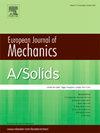Is the decoupling into plane and antiplane singular eigensolutions always possible in corners with frictional contact?
IF 4.4
2区 工程技术
Q1 MECHANICS
引用次数: 0
Abstract
Consider stress singularities in semiinfinite linear elastic corners under generalized plane strain (GPS), where elastic variables do not change along the longitudinal direction . It is commonly assumed that if the material in the corner has an elastic symmetry plane , the singular eigensolutions can be decomposed into plane and antiplane solutions. This has traditionally been assumed regardless of the boundary and interface conditions applied on the corner faces. The present work shows that this assumption should not be made if there is sliding friction contact, even with a low coefficient of friction, on the interface between the materials or on the boundary of the corner because some eigensolutions might be overlooked. It is shown that unexpected asymmetric eigensolutions may exist in which the plane and antiplane modes cannot be decoupled despite the elastic symmetry in the corner. Examples of such unexpected asymmetric eigensolutions are computed and analyzed for isotropic and orthotropic single- and bi-material corners. The key is to perform the corner singularity analysis under GPS without assuming the sliding angle on the friction faces. In some corner configurations, these unexpected strange coupled eigensolutions are the most singular of all eigensolutions satisfying the friction energy dissipation condition, thus, they could govern damage initiation at these corners.

求助全文
约1分钟内获得全文
求助全文
来源期刊
CiteScore
7.00
自引率
7.30%
发文量
275
审稿时长
48 days
期刊介绍:
The European Journal of Mechanics endash; A/Solids continues to publish articles in English in all areas of Solid Mechanics from the physical and mathematical basis to materials engineering, technological applications and methods of modern computational mechanics, both pure and applied research.

 求助内容:
求助内容: 应助结果提醒方式:
应助结果提醒方式:


